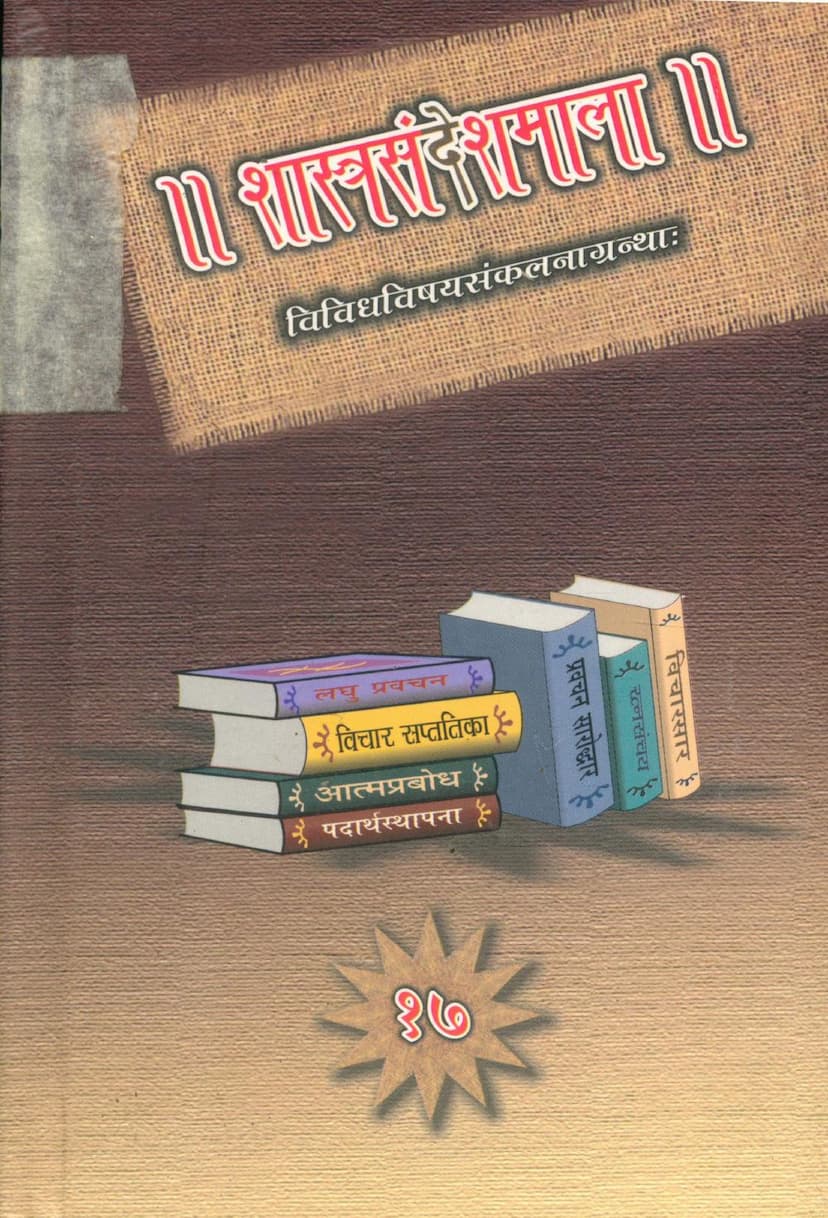Shastra Sandesh Mala Part 17
Added to library: September 2, 2025

Summary
Shastra Sandesh Mala Part 17: A Comprehensive Summary
This Jain text, Shastra Sandesh Mala Part 17, compiled by Vinayrakshitvijay and published by Shastra Sandesh Mala, is a rich compendium of Jain scriptures and teachings. The catalog link provided leads to a digital version of the book, which spans 289 pages and covers a vast array of topics related to Jain philosophy, practices, and history.
Key Themes and Content Areas:
The book appears to be a collection of various Jain texts, potentially sermons, treatises, and historical accounts, presented in a structured manner. Based on the provided pages, the following key themes and content areas can be identified:
1. Core Jain Principles and Practices:
- Ahimsa (Non-violence): Numerous verses and explanations likely delve into the paramount importance of non-violence towards all living beings, a cornerstone of Jainism.
- Aparigraha (Non-attachment): The concept of detachment from worldly possessions and desires would be a recurring theme, emphasizing its role in spiritual liberation.
- Anekanta (Multi-sidedness): The Jain principle of viewing reality from multiple perspectives is likely explored, promoting tolerance and understanding.
- Samyak Darshan (Right Faith), Samyak Gyan (Right Knowledge), and Samyak Charitra (Right Conduct): These three pillars of Jainism are undoubtedly central, guiding individuals towards spiritual purification and moksha.
- Tapas (Austerities): The text likely details various forms of austerities and their significance in shedding karma and advancing spiritually.
- Swadhyaya (Self-study): The profound meaning of self-study as the study of the soul is emphasized, highlighting its role in attaining detachment and spiritual progress.
- Vows (Mahavratas and Anuvratas): The book would elaborate on the vows undertaken by monks, nuns, and lay followers, outlining their scope and implications.
- Pondering the Soul (Aatma-vichar): The text emphasizes the importance of introspection and understanding the nature of the soul.
- Spiritual Practices: Various practices like meditation, contemplation, and adherence to Jain rituals would be discussed.
- Karma Theory: The intricate workings of karma, its bondage, fruition, and methods for its shedding, are likely extensively covered.
2. Jain Cosmology and Mythology:
- Cosmological Calculations: The text provides extensive details on Jain cosmology, including calculations related to the universe, lifespan of beings, celestial bodies, and the various realms of existence (heav enly beings, hellish beings, humans, animals). This includes detailed accounts of geographical divisions like Jambudvipa, Bharat Kshetra, and the measurements of mountains like Meru.
- Jinas and Their Teachings: The book would extensively cover the lives, teachings, and nirvana of the Tirthankaras (Jinas) and other spiritual leaders.
- Buddha and Bodhi: The concept of enlightenment (Bodhi) and the path to it would be a significant aspect.
- Demons and Deities: References to various celestial beings, demi-gods, and their roles in the cosmic order might be present.
- Historical Accounts: The text may include historical anecdotes and lineages of spiritual teachers and prominent Jain figures.
3. Scriptural Knowledge and Methodology:
- Pravachana Saroddhara and Laghu Pravachana Saroddhara: The presence of these titles indicates a focus on the essence and summaries of Jain doctrines, making complex teachings accessible.
- Ratna Sanchaya (Collection of Jewels): This title suggests a compilation of precious teachings or principles.
- Vichara Saptatika (Seventy Points of Contemplation): This indicates a structured approach to contemplating key Jain concepts.
- Padartha Sthapana Sangraha (Collection of Establishing the Nature of Substances): This implies a detailed exposition of the Jain metaphysical categories (like souls, matter, space, time, dharma, adharma).
- Vichara Sara (Essence of Contemplation): This title suggests a focus on the core contemplative aspects of Jainism.
- Puranas and Scriptures: The text likely draws from and references various ancient Jain Puranas and foundational scriptures.
- Grammar and Language: The meticulous detailing of terms and their nuances, including the numerical data presented across numerous pages, suggests a deep engagement with the scriptural language.
- Classification and Enumeration: The text exhibits a systematic approach to classifying and enumerating various elements, from the numbers of Tirthankaras, their lifespans, and the celestial beings to the specific details of Jain practices and their associated rules.
4. Specific Details and Enumerations: The sheer volume of numerical data and specific enumerations throughout the pages (e.g., number of Tirthankaras in different regions, lifespans, types of austerities, classifications of souls, detailed rules for practices, names of various spiritual beings, astronomical data, measurements of the universe) highlights a commitment to providing exhaustive scriptural knowledge.
5. Publisher and Contributors: The publication details mention the Shastra Sandesh Mala as the publisher. The text acknowledges the inspiration and guidance of Pujya Panyas Shri Bodhiratna Vijayji M.S. and the compilation by Pujya M. Shri Vinayrakshitvijayji M.S. The first edition was published in V.S. 2061 (2004 CE). Special notes indicate that parts 1 to 20 of Shastra Sandesh Mala were published from "Gyanadravya" (knowledge fund), and the publication of this particular volume was supported by the Shri Sangh and the Trustees of the Aradhana Bhavan Trust, Ratlam. The book also expresses gratitude to various Jain libraries and institutions for their assistance in obtaining source texts. The meticulous proofreading and typesetting efforts by Pandit Ratiibhai Chimanlal Doshi, Payal Printers, Shriji Graphics, and Shivkrupa Offset Printers are also acknowledged.
Overall Impression:
"Shastra Sandesh Mala Part 17" appears to be an invaluable resource for anyone seeking a deep and comprehensive understanding of Jainism. It is a scholarly compilation that not only presents the core tenets of the religion but also delves into intricate details of its cosmology, history, and practices. The emphasis on accuracy, as seen in the acknowledgments of proofreading and validation by learned individuals, suggests the text is a reliable and authoritative source for Jain knowledge. The dedication to making this vast knowledge accessible through the "Gyanadravya" signifies a commitment to Jain education and dissemination.